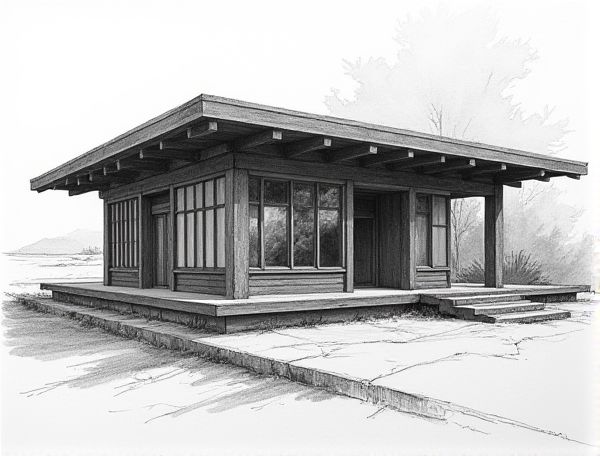
Photo illustration: Shou Sugi Ban home design with charred timber cladding
Shou Sugi Ban home design utilizes charred timber cladding to create a durable, weather-resistant exterior that also adds a striking, textured aesthetic to your home. Discover how this traditional Japanese technique combines sustainability with modern elegance by reading more in the article.
Introduction to Shou Sugi Ban and Its Origins
Shou Sugi Ban is a traditional Japanese wood preservation technique that involves charring the surface of wood to enhance its durability and resistance to weather and pests. Originating in Japan during the Edo period, this method was initially developed to protect exterior siding and extend the lifespan of cedar wood. The process not only strengthens the wood but also creates a unique, textured aesthetic sought after in modern home design for its blend of natural beauty and functional resilience.
The Art of Charring Timber: Shou Sugi Ban Explained
Shou Sugi Ban is a traditional Japanese technique that enhances the durability and aesthetic appeal of timber by charring its surface, resulting in a weather-resistant, termite-proof, and low-maintenance finish. Incorporating this method into your home design elevates both the texture and longevity of wooden elements, blending natural beauty with innovative preservation.
Unique Aesthetic Appeal of Charred Timber Cladding
Charred timber cladding offers a unique aesthetic appeal by blending rustic charm with modern sophistication, creating a striking visual contrast against natural surroundings. Its deep, textured finish not only enhances the architectural character but also provides excellent durability and weather resistance. Incorporating this distinctive material into your home design elevates both style and longevity, making a bold statement in exterior design.
Benefits of Shou Sugi Ban in Modern Home Design
Shou Sugi Ban offers exceptional durability and resistance to fire, insects, and decay, making it a sustainable choice for modern home design. Its unique charred wood texture enhances aesthetic appeal while requiring minimal maintenance compared to traditional wood finishes. Incorporating Shou Sugi Ban can increase the longevity and eco-friendliness of both interior and exterior architectural elements.
Best Wood Species for Shou Sugi Ban Cladding
Cedar, cypress, and redwood are the best wood species for Shou Sugi Ban cladding due to their natural durability and resistance to decay and insects. Cedar's tight grain and high resin content enhance the charring process, creating a protective, weather-resistant surface that lasts for decades. Cypress offers exceptional moisture resistance, making it ideal for exterior cladding applications exposed to varying weather conditions.
Shou Sugi Ban for Exterior Versus Interior Applications
Shou Sugi Ban, a traditional Japanese technique, enhances exterior surfaces by providing durable, weather-resistant, and fireproof wood cladding, ideal for facades and siding exposed to harsh environmental elements. When applied to interiors, the charred wood delivers a unique aesthetic with textured, rich tones but requires sealing to prevent soot and dust, making it more suitable for accent walls or decorative features rather than high-traffic areas. Selecting Shou Sugi Ban for exterior use leverages its long-lasting protection, while interior applications demand careful maintenance to preserve the finish and indoor air quality.
Sustainability and Eco-Friendly Aspects of Charred Timber
Charred timber, also known as Shou Sugi Ban, enhances sustainability in home design by increasing the wood's durability and resistance to pests and weather, reducing the need for chemical treatments and frequent replacements. Its eco-friendly nature stems from utilizing natural fire to preserve wood, minimizing harmful emissions and promoting longevity compared to synthetic alternatives. Incorporating charred timber supports responsible forestry practices and reduces the carbon footprint associated with conventional building materials.
Maintenance and Longevity of Shou Sugi Ban Cladding
Shou Sugi Ban cladding requires minimal maintenance due to its charred surface, which naturally resists rot, insects, and UV damage, significantly extending the lifespan of your home's exterior. By choosing this traditional Japanese wood preservation technique, you enhance durability and reduce the need for frequent treatments, ensuring lasting beauty and protection for years.
Shou Sugi Ban in Contemporary Architectural Trends
Shou Sugi Ban, a traditional Japanese technique of charring wood, is gaining popularity in contemporary architectural trends for its durability, fire resistance, and distinct aesthetic qualities. Architects favor this method for creating visually striking facades and interiors that blend natural textures with modern design principles. Sustainable and low-maintenance, Shou Sugi Ban enhances wood longevity, making it an ideal choice for eco-friendly residential projects.
Inspiring Shou Sugi Ban Home Designs and Case Studies
Shou Sugi Ban, an ancient Japanese technique of charring wood, enhances home designs by providing striking textured facades and exceptional durability against weather and pests. Case studies reveal that integrating Shou Sugi Ban in modern homes not only elevates aesthetic appeal but also promotes sustainability through the use of natural, fire-resistant materials.
 homedesy.com
homedesy.com